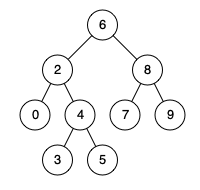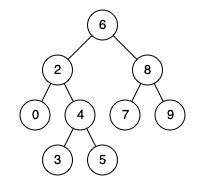Given a binary search tree (BST), find the lowest common ancestor (LCA) of two given nodes in the BST.
According to the definition of LCA on Wikipedia: “The lowest common ancestor is defined between two nodes p and q as the lowest node in T that has both p and q as descendants (where we allow a node to be a descendant of itself).”
Example 1:

Input: root = [6,2,8,0,4,7,9,null,null,3,5], p = 2, q = 8
Output: 6
Explanation: The LCA of nodes 2 and 8 is 6.
Example 2:

Input: root = [6,2,8,0,4,7,9,null,null,3,5], p = 2, q = 4
Output: 2
Explanation: The LCA of nodes 2 and 4 is 2, since a node can be a descendant of itself according to the LCA definition.
Example 3:
Input: root = [2,1], p = 2, q = 1
Output: 2
Constraints:
- The number of nodes in the tree is in the range [2, 105].
-10^9 <= Node.val <= 10^9- All Node.val are unique.
- p != q
- p and q will exist in the BST.
Solution in python:
# Definition for a binary tree node.
# class TreeNode:
# def __init__(self, x):
# self.val = x
# self.left = None
# self.right = None
class Solution:
def lowestCommonAncestor(self, root: 'TreeNode', p: 'TreeNode', q: 'TreeNode') -> 'TreeNode':
def traverse(root):
if root == None:
return
else:
if root.left != None:
adic[root.left.val] = root
traverse(root.left)
if root.right != None:
adic[root.right.val] = root
traverse(root.right)
adic = {root.val:root}
traverse(root)
alist = [p.val]
while p != root:
alist.append(p.val)
p = adic[p.val]
alist.append(root.val)
while q.val not in alist:
q = adic[q.val]
return q
留言